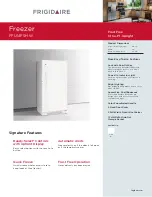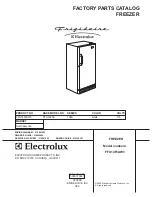
22
Cleaning
• Do not use hard brushes, cleaning steel
balls, wire brushes, abrasive substances
such as toothpaste, organic solvents
such as alcohol, acetone, banana oil, etc.,
boiling water, acid or alkaline items to
clean the appliance because these sub-
stances will damage the interior and ex-
terior surfaces of the freezer.
1. Regularly dust behind the freezer and
beneath it. This will improve the cooling
efficiency and saves energy.
2. The interior of the freezer should be
cleaned regularly to avoid odors. A soft
towel or a sponge dipped in a water and
noncorrosive neutral detergent solution
is suggested for cleaning the interior.
3. To finish the cleaning, wipe the appli-
ance using a cloth dampened in clean
water and the use a soft and dry cloth.
4. Before turning on the appliance, leave
doors open so the interior is air-dried.
WARNING: BEFORE PERFORM-
ING ANY CLEANING JOB, UN-
PLUG THE APPLIANCE FROM
THE POWER SOURCE.
• Do not rinse with water because this will
affect the electrical insulation system.
Use a soft and dry cloth when cleaning
temperature control knob and electrical
components.
Defrost
The freezer should be manually defrosted.
1. Unplug the freezer and open the door(s).
2. Remove food items and drawers before
defrosting.
3. Open the drain holes by removing the
caps, and place a container to catch the
defrost water.
Let the frost to naturally melt. Wipe the de-
frost water with a dry and soft cloth. When
the frost softens, an ice scraper might be
used to remove it.
Place the food items in a cool place while
defrosting the unit.
WARNING: DO NOT USE ANY
DEVICE TO ACCELERATE THE
DEFROSTING PROCESS. DO
NOT DAMAGE THE REFRIGER-
ATING CIRCUIT.
Maintenance instructions











































